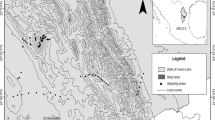Abstract
By means of ordination and classification techniques, the relationships between climate, soils, human activities and vegetation along an altitudinal gradient of the Venezuelan páramos are analyzed and interpreted. The altitudinal gradient chosen is characterized by decrease of temperature, precipitation, soil fertility, soil water-holding capacity, and plant cover as altitude increases. The ordination results suggest vegetation changes to be primarily related to environmental changes occurring with altitude, and secondly to disturbances caused mainly by grazing. Some results point toward a disjunction in the vegetational gradient occurring at ca. 3 500 m.a.s.l. and separating low and high páramo. This disjunction might have been caused by the glacial history of the páramos and the occurrence of frequent night-frosts.
The soil samples were kindly analyzed by the Laboratorio de Edafologia, Centro Nacional de Investigaciones Agropecuarias. Help in plant identification was generously obtained from the specialists of Instituto Botánico, Instituto Nacional de Parques, Caracas.
Similar content being viewed by others
References
Baruch, Z., 1979. Elevational differentiation in Espeletia schultzii, a giant rosette plant of the Venezuelan páramos. Ecology 60: 85–98.
Baruch, Z. & Smith, A. P., 1979. Morphological and physiological correlates of niche breadth in two species of Espeletia (Compositae) in the Venezuelan Andes. Oecologia 38: 71–82.
Beals, E. W., 1969. Vegetational change along altitudinal gradients. Science 165: 981–985.
Bouyoucos, G. J., 1936. Directions for making mechanical analyses of soils by the hydrometer method. Soil Sci. 32: 225–228.
Cleef, A. M., 1981. The vegetation of the páramos of the Colombian Cordillera Oriental. Dissertationes Botanicae, Band 61. J. Cramer, Vaduz.
Cuatrecasas, J., 1968. Páramo vegetation and its life forms. Coll. Geogr, 9: 163–186.
Cuatrecasas, J., 1976. A new sub-tribe in the Helianthease (Compositae): Espeletiinae. Phytologia 35: 43–61.
Fariñas, M. & Monasterio, M., 1980. La vegetación del páramo de Mucubaji: analisis de ordenamiento y su interpretation ecologica. In: M. Monasterio (ed.). Estudios Ecológicos de los Páramos Andinos, pp. 263–307. Ediciones de la Universidad de Los Andes, Mérida.
Gauch, H. G.Jr., 1977 ORDIFLEX: a flexible computer program for four ordination techniques. Cornell Ecology Series. University of Cornell, Ithaca, New York.
Gauch, H. G.Jr., Whittaker, R. H. & Wentworth, T. R., 1977. A comparative study of reciprocal averaging and other ordination techniques. J. Ecol. 65: 157–174.
Hammen, J.van der, 1974. The Pleistocene changes of vegetation and climate in tropical South America. J. Biogeogr. 1: 3–26.
Hill, M. O., 1979a. TWINSPAN: A FORTRAN program for arranging multivariate data in an ordered two-way table by classification of the individuals and the attributes. Cornell Ecology Programs Series. Cornell University, Ithaca, New York.
Hill, M. O., 1979. DECORANA: A FORTRAN program for detrended correspondence analysis and reciprocal averaging. Cornell Ecology Programs Series. Cornell University, Ithaca, New York.
Hill, M. O. & Gauch, H. G.Jr., 1980. Detrended correspondence analysis: an improved ordination technique. Vegetatio 42: 47–58.
Lozano, C. G. & Schnetter, R., 1976. Estudios ecológicos en el páramo de Cruz Verde, Colombia. 11 — Las communidades vegetales. Caldasia XI (54): 53–68.
Monasterio, M., 1980. Las formaciones vegetales de los páramos de Venezuela. In: M. Monasterio (ed.). Estudios Ecológicos de los Páramos Andinos, pp. 93–158. Ediciones de la Universidad de los Andes, Mérida.
Moral, R.del & Watson, A. F., 1978. Gradient structure of forest vegetation in the Central Washington Cascades. Vegetatio 38: 29–49.
Mueller-Dombois, D. & Ellenberg, H., (1974). Aims and Methods of Vegetation Ecology. John Wiley & Sons, New York.
Nie, N. H., Hull, C. H., Jenkins, J. G., Steinbrenner, K. & Bent, D. H., 1975. Statistical Package for the Social Sciences. McGraw-Hill, New York.
Peet, R. K., 1974. The measurement of species diversity. Ann. Rev. Ecol. Syst. 5: 285–307.
Peet, R. K., 1978. Forest vegetation of the Colorado Front Range: patterns of species diversity. Vegetatio 37: 65–78.
Richards, L. A., 1949. Methods of measuring soil moisture tension. Soil Sci. 68: 95–112.
Schubert, C., 1980. Aspectos geológicos de los Andes Venezolanos: Historia, breve sintesis del Cuaternario y bibliografiá. In: M. Monasterio (ed.). Estudios Ecológicos de los Páramos Andinos, pp. 29–46. Ediciones de la Universidad de los Andes, Mérida.
Smith, A. P., 1974. Population dynamics and life form of Espeletia in the Venezuelan Andes. Ph. D. Dissertation. Duke University, Durham, N. Carolina.
Smith, J. M. B., 1977. Vegetation and microclimate of east and west facing slopes in the grasslands of Mt. Wilhem, Papua New Guinea. J. Ecol. 65: 39–53.
Vareschi, V., 1970. La Flora de los Páramos, Ediciones del Rectorado. Universidad de los Andes, Mérida.
Vuilleumier, B. S., 1971. Pleistocene changes in the fauna and flora of South America. Science 173: 771–780.
Whittaker, R. H., 1967. Gradient analysis of vegetation. Biol. Rev. 49: 207–264.
Whittaker, R. H. & Niering, W. A., 1965. Vegetation of the Santa Catalina mountains, Arizona. II —A gradient analysis of the south slope. Ecology 46: 429–452.
Author information
Authors and Affiliations
Additional information
Nomenclature follows Vareschi (1970).
Acknowledgements: This work was supported by the Decanato de Investigaciones, Universidad Simón Bolivar. I wish to thank A. Pacheco for help in the field sampling. Dr O. Arenas help was invaluable in the mathematical treatment of the data. Drs A. Vivas and J. M. B. Smith provided useful criticism to an earlier version of this work.
Rights and permissions
About this article
Cite this article
Baruch, Z. Ordination and classification of vegetation along an altitudinal gradient in the Venezuelan páramos. Vegetatio 55, 115–126 (1984). https://doi.org/10.1007/BF00037333
Accepted:
Issue Date:
DOI: https://doi.org/10.1007/BF00037333



